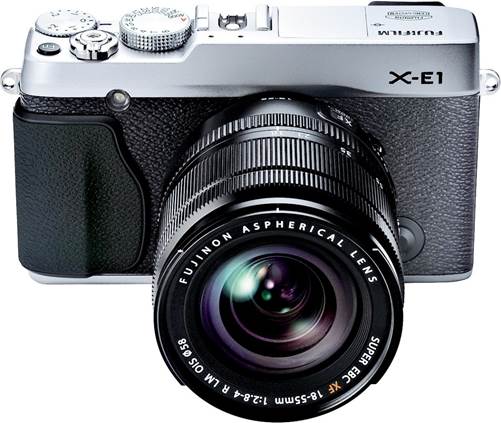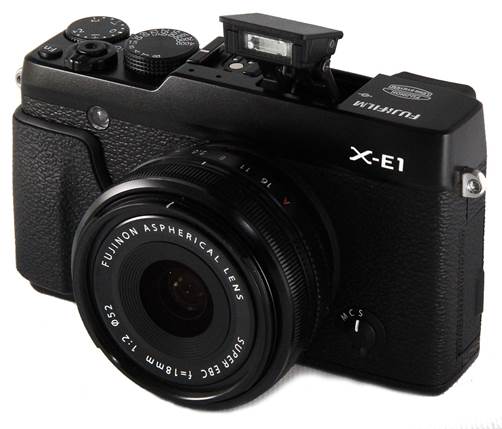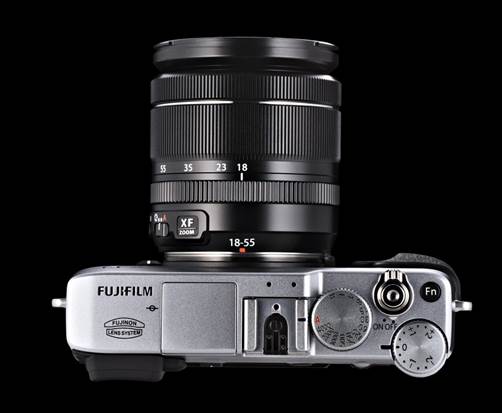Fujifilm has been on fire riding the retro,
mirror-less combination in recent months. First came the X100, then the X10 and
the X-Pro1. Now here comes the X-E1.
The X-E1 is essentially a smaller version of
the X-Pro1. The main difference is that it loses the optical view finder, but
keeps an electronic viewfinder (EVF). Also, the X-E1 comes with a built-in
flash, which the X-Pro1 lacks. Internally, the X-E1 comes with the same 16MP
APS-C X-Trans CMOS sensor and image processing engine as the X-Pro1.

First
came the X100, then the X10 and the X-Pro1. Now here comes the X-E1.
Design & Handling
The Fujifilm X-E1 is beautiful. Its looks
are a straight derivative from the Fujifilm X100 to the X-Pro1 and before that
from the rangefinders of old. We feel it’s well-built, but there are some who
complain about it feeling too plastic KY. Well, it’s not any more
plastic-feeling than a DSLR you’d get at the same price.
But this isn’t a DSLR. The X-E1invokes a
more considered kind of shooting; not a camera you bring to snap bursts
willy-nilly. The X-E1 is a technical camera; it has its manual controls laid
out on the body, which will certainly appeal to old-time camera users who know
how to use them, but it might confuse beginners.

The
X-E1invokes a more considered kind of shooting; not a camera you bring to snap
bursts willy-nilly.
The biggest difference between the X-E1 and
the X-Pro1 is the removal of the optical viewfinder (OVF). It still comes with
an electronic viewfinder (EVF), which helps to reduce the cost of the camera.
And the EVF is actually better than the one on the X-Pro1, it’s slightly bigger
(0.5” across compared to 0.47”), higher resolution (2.36 million dots compared
to 1.44 million) and comes with a diopter (built-in versus none). Instead of
LCD technology, it’s OLED. In the field, the EVF works pretty well, even with
moving subjects. It’s not as luxurious as an OVF, but if that’s essential for
you then there’s always the X-Pro1.
Overall, the X-E1 experience is a positive
one, more like a concentrated X-Pro1 instead of a watered-down X-Lite. But we
feel that the camera misses a few opportunities to further evolve the line’s
handling. Auto ISO doesn’t let you set a minimum shutter speed, which can be quite
frustrating if you prefer shooting in Aperture Priority – the X-E1 seems to
prefer lower ISO settings and slower shutter speeds.

It’s
not as luxurious as an OVF, but if that’s essential for you then there’s always
the X-Pro1.
Auto-focus is much improved (more on that
in Image Performance), but AF point selection still isn’t. There’s a dedicated
AF button, just like on the X-Pro1, but its use is limited. In AF Multi mode,
where the camera automatically selects an AF point, it does nothing. It’s only when
you’re in AF Area mode, where you choose the AF point manually, that the AF
button activates AF point selection.
When in AF Area, selecting AF points then
takes a little bit of finger gymnastics. You have to press the AF button screen
and then use the d-pad to select a point. These two buttons are on opposite
ends of the camera, which makes changing AF points a two-handed operation,
sometimes with your face up to the EVF, in the way of your fingers.
Image Performance
One of the exciting things about the Fujifilm
X-Pro1 and X-E1 is how the cameras do away with the AA filter (also known as an
optical low-pass filter). The AA filter in most digital cameras prevents nasty
things like moiré artifacts from appearing in your photographs, but at the cost
of some fine detail, so it always looks like there’s a film of blurriness
overlaid on your images.
A camera without the AA filter, like the
X-E1, produces images which look that much clearer, that much sharper, with
more clarity and crispness in the details. To be fair, if you don’t pixel peep,
you probably won’t see the difference on Facebook. But if you do, and it’s a
fair bet that anyone who gets an X-E1 will, you’ll certainly appreciate the
difference.

The
X-E1 scores a remarkable 2600 LPH (vertical and horizontal) on our resolution
chart.
The X-E1 scores a remarkable 2600 LPH
(vertical and horizontal) on our resolution chart. It’s also a solid low-noise
performer, shooting at high ISO sensitivities that buck lesser cameras. With
the X-E1, it’s certainly possible to shoot up to ISO 6400 with easy confidence,
the camera manages to keep noise down while retaining a high level of detail
not yet seen in other mirror-less system cameras. Even ISO 12,800 is not
complete rubbish.
The X-Pro1 had a problem with color smearing,
where a color would run over and contaminate adjacent areas. Color smearing
doesn’t appear in all images, but there are samples of it online. We haven’t
seen it in our own images, but we have seen what we can only describe as odd
edge glows, where a halo or double-edge appears in certain subjects. It doesn’t
happen all the time, and you might not even notice it if you don’t zoom into
your picture.
Photographers who shoot in raw will also
want to note that the X-Trans sensor’s raw conversion in apps other than
Fujifilm’s SILKYPIX seem to have problems getting rid of the color smearing. If
you’re someone who works exclusively in raw and Adobe, the X-E1 might present a
workflow hiccup for you.
Auto-focus is certainly snappier than the
X-Pro1 when it first launched, it’s able to find and lock onto subjects with
reasonable speed. That said, it’s also not state of the art fast in a year when
we have Olympus, Panasonic and Nikon providing ultra-fast auto-focus systems
that can even recognize faces.
Conclusion
The X-E1 is certainly a fine camera which
will produce a lot of beautiful images, but it’s not perfect by any means.
Faster AF speeds over the X-Pro1 make it an easier camera to love, but it’s
still a camera for a considered, slower pace of shooting than something with a
wicked fast AF like the Olympus E-M5 or a DSLR camera.
The X-E1 is certainly not for someone who
wants to shoot video, recording capability on the camera seems almost like an
afterthought. While it can shoot 1080/24p video with stereo, you’ll notice that
there are no video controls placed front and center. This is really a stills
camera geared for the stills photographer.
The X-E1 is cheaper than the X-Pro1, but
it’s not cheap by any means. The X-E1 with the XF 18-55mm kit lens will set you
back $2,099, while the body alone is $1,499. The X-Pro1 body alone was $2,399.
Lest you think that’s a massive discount, consider the competition; there are
other cameras that can get you, if not as good, but good enough image quality
for less money.
The best thing about the X-E1 is that we
never felt, at any point, that it was a diluted version of the X-Pro1. Rather,
the X-E1 feels to us like a condensed version of its more expensive
predecessor, with all its strengths as well as weaknesses.
|
Specifications
§ 16MP
X-Trans CMOS sensor
§ ISO
200-6400, 100 - 25600 expanded (JPEG only)
§ 2.36M
dot OLED electronic viewfinder
§ New
kit zoom: 18-55mm F2.8-4R
§ Same
control layout as X-Pro1, including top-plate shutter speed and exposure
compensation dials
§ 2.8"
460k-dot LCD
§ Built-in
pop-up flash
§ Full
HD movie recording with built-in stereo microphone
§ 2.5mm
stereo microphone socket
§ Compatibility
with wired remote control units (via either the USB port or mic socket)
§ Available
in silver or black
|